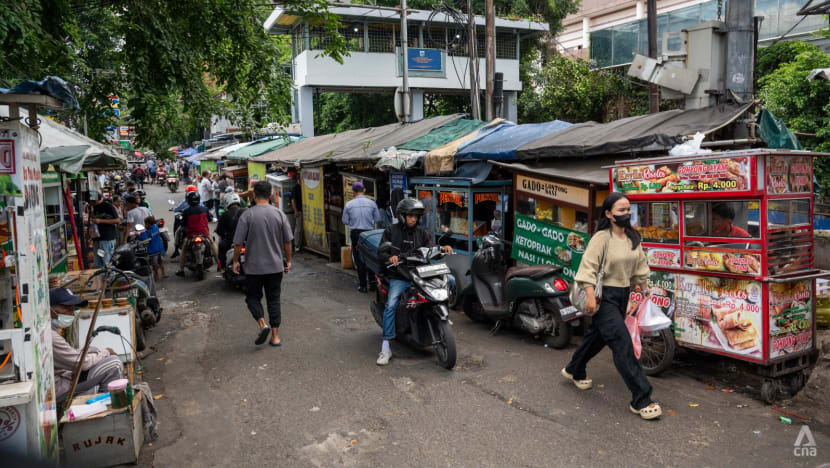Commentary: Indonesia’s jobs boom is a story of quantity, not quality
Stagnant wages, rising underemployment and limited upward mobility reveal a labour market defined more by quantity than quality, say two academics.

A food stall scene in the Kebon Kacang area, Jakarta, on April 24, 2025. (Photo: CNA/Ridhwan Siregar)
YOGYAKARTA: Indonesia is creating jobs at an unprecedented rate. In 2024 alone, the country added 4.8 million new jobs, pushing the unemployment rate below 5 per cent as gross domestic product growth rebounded to 5 per cent.
While this appears groundbreaking on paper, national sentiment and statistics tell a different story.
Workers are anxious, households feel stuck, and young graduates are scrambling for jobs to match their qualifications. Despite consistent job growth, social mobility remains difficult, with the number of Indonesians in the middle class falling since 2018.
The core problem is not employment itself, but the nature of employment. According to Indonesia’s National Labour Force Survey, the country created around 18 million jobs between 2018 and 2024.
But more than 80 per cent were in household enterprises, while just 2.6 million jobs came from corporations and large factories, with fewer than a million jobs created in government-related roles.
Household enterprises like street vendors, home-based workers and family-run shops may offer flexibility, but they are deeply informal and poorly paid. In 2023, nearly 59 per cent of Indonesia’s workers were employed informally without insurance and earning below the minimum wage.
In most cases, employees in household enterprises face a persistent wage penalty. In their first year, they earn on average 9.6 per cent less than government employees and 57.6 per cent less than corporate employees. With an average starting wage of just 1.6 million rupiah (US$96.50) per month, these jobs fall short of what it takes to join the middle class.
UNDEREMPLOYMENT CRISIS
This divide is pronounced across sectors. Sectors with the lowest wages and job quality such as agriculture and food services led job creation, with agriculture alone adding over 4.2 million jobs. But sectors that offer stable, better-paying work like finance, health and public administration added far fewer jobs.
Most new manufacturing jobs are found in micro-scale, low-tech operations with low product complexity like food and beverage processing.
Real wage data also reveals a troubling trend – adjusted for inflation, real wages have not grown since 2018. At the same time, between 2018 and 2024, the average number of hours worked fell across almost every sector, from agriculture to finance. This rise in low-hour employment has driven a surge in underemployment – around 30 per cent of Indonesia’s workforce work under 35 hours per week.
Although millions of Indonesians are technically employed, they are often stuck in jobs without enough hours or sufficient income to sustain a good life. This quiet epidemic of underutilisation erodes productivity and strains household budgets, pushing many workers into a loop of part-time labour and full-time insecurity.
Indonesia’s underemployment crisis is even more concerning when considering worker aspirations. In 2024, nearly 16 million Indonesian workers reported wanting to work more hours, an increase of almost 80 per cent from 2018. Over 83 per cent of these underemployed workers were concentrated in household enterprises.
The institutions most capable of offering stable, full-time employment are shrinking, while the informal sector balloons with workers who want but cannot find enough hours.
POLICIES FOR QUALITY EMPLOYMENT
Indonesia must reorient its policy towards quality employment, including by incentivising employers to hire formally and pay fairly. Indonesia can learn from Chile’s Subsidio al Empleo Joven (Youth Employment Subsidy), which offers wage subsidies to enterprises hiring vulnerable young workers, while linking social security benefits and access to credit to formal employment status.
OECD evaluations show that this program has raised the probability of formal employment by 3 per cent and led to higher earnings for beneficiaries. Adopting similar targeted incentives can encourage more businesses to provide decent and secure employment.
Improving job quality is not solely the responsibility of the government. The Central Bank also has a role to play by recognising the economic slack created by underemployment. Indonesia should rely on a comprehensive dashboard of labour market indicators to set monetary policy, rather than a single headline unemployment figure.
An economy may boast record-low unemployment and strong job creation, yet persistent underemployment or weak labour force participation signals that substantial slack remains beneath the surface.
In these cases, central banks may be wise to hold back from aggressive tightening to avoid stifling a still-fragile economic recovery. By embracing broader labour measures, monetary and fiscal policy can be calibrated more precisely, uncovering hidden slack or overheating pressures that the official employment growth rate alone fails to reveal.
Indonesia also needs to strike a bold national conversation on job quality standards, while employers must provide a decent minimum wage, stronger job security, increased social protections and self-development opportunities. Good jobs are not luxuries, but preconditions for a healthy and inclusive economy.
Indonesia’s economic engine continues to grow. But if the jobs it produces are low-wage, informal and dead-end, the country risks building a future where work does not deliver dignity. Indonesia’s economy will not be measured by how fast it grows, but by how many people rise with it.
Kelvin Ramadhan is Research Fellow at EQUITAS, and Wisnu Setiadi Nugroho is Assistant Professor at the Faculty of Economics and Business, Universitas Gadjah Mada. This commentary first appeared on East Asia Forum.














